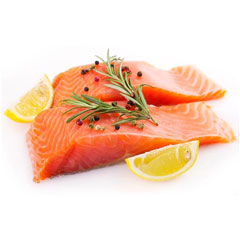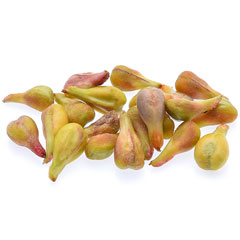



Eye-SEA™ is specifically formulated by board certified veterinary ophthalmologists for long term ocular health in large animals.










Eye-SEA™ is a unique blend of select antioxidants that provides support to all structures of the eye. This supplement is formulated such that each ingredient, which is well-described below, works in concert with the others to optimize antioxidant activity and support overall ocular health.
Eye-SEA™ has been formulated by veterinary ophthalmologists based on clinical research.
The beadlet form of lutein is derived from the marigold plant and is a particularly potent antioxidant.8 Both lutein and zeaxanthin9 concentrate in the cones of the retina to attenuate harmful wavelengths of blue light, found in the visible light spectrum and in UV rays. Over time, retinal exposure to blue light leads to degeneration, so by protecting the retina from these harmful wavelengths, retinal health is preserved as the pet ages.
Alpha lipoic acid (ALA) is found in small amounts in all mammalian tissues.10 ALA is an aldose reductase inhibitor, which discourages circulating sorbitol, and subsequent glucose, from depositing in the lens. ALA is also a strong antioxidant that supports the availability of circulating ascorbate, vitamin E, and glutathione for tissue use.
Vitamin E is a fat-soluble vitamin that is a potent antioxidant. Fatty acid oxidation occurs during the processing of fish fed to marine animals, which degrades naturally occurring vitamin E. Supplementation therefore provides animals with antioxidant support to maintain a healthy immune system while under human care.
Folic acid supports the body’s natural antioxidant defenses as a cofactor for S-adenosyl-L-methionine (SAMe) and homocysteine recycling.
Coenzyme Q10 is a lipid soluble antioxidant that helps to maintain normal fat metabolism. It has been proven to decrease in the human eye with age, so supplementation helps protect the retina from age-related change.
1 Williams D, Fitchie A, Colitz C. An oral antioxidant formulation delaying and potentially reversing canine diabetic cataract: A placebo-controlled double-masked pilot study. International Journal of Diabetes and Clinical Research. 2015, 2:1.
2 Vinson JA. Review: Oxidative stress in cataracts. Pathophysiology. 2006. 13: 151-162.
3 Chucair AJ, Rotstein NP, SanGiovanni JP, et al. Lutein and zeaxanthin protect photoreceptors from apoptosis induced by oxidative stress: relation with docosahexaenoic acid. Investigavitve Ophthalmology and Visual Science. 2007. 28: 5168-77.
4 Gupta SK, Trivedi D, Srivastava S, et al. Lycopene attenuates oxidative stress induced experimental cataract development: an in vitro and in vivo study. Nutrition. 2003. 18: 794-799.
5 Grizzle J, Hadley TL, Rotstein DS, et al. Effects of dietary milk thistle on blood parameters, liver pathology, and hepatobiliary scintigraphy in white carneaux pigeons (Columba livia) challenged with B1 aflatoxin. Journal of Avian Medicine and Surgery. 2009. 23 (3): 114-124.
6 Colitz CMH. Saville WJA, Renner MS, McBain JF, Rediarson TH, Schmitt TL, Nolan EC, Dugan SJ, Knightly F, Rodriguez MM, Mejia-Fava JC, Osborn SD, Clough PL, Collins SP, Osborn BA, Terrell K. Risk factors associated with cataracts and lens luxations in captive pinnipeds in the United States and the Bahamas. Aquatic Animals. 2010. 237 (4): 429-436.
7 Durukan AH, Everklioglu C, Hurmeric V, et al. Ingestion of IH636 grape seed proanthocyanidin extract to prevent selenite-induced oxidative stress in experimental cataract. Journal of Cataract and Refractive Surgery. 2006. 32: 1041-1050.
8 Koutsos EA, Schmitt T, Colitz CM, Mazzaro L. Absorption and ocular deposition of dietary lutein in marine mammals. Zoo Biology. 2013. 32 (3): 315-323.
9 Krinsky NI. Possible biological mechanisms for a protective role of xanthophylls. Journal of Nutrition. 2002. 132: 540S-542S.
10 Jocelyn PC. Thiols and disulfides in animal tissues. Biochemistry of the SH groups. London: Academic Press. 1972.
11 Biewenga GP, Haenen GR, A Bast. The pharmacology of the antioxidant lipoic acid. General Pharmacology. 1997; 29(3): 315-31.
Cautions: Safe use in pregnant animals or animals intended for breeding has not been proven.| Weight (lbs.) | Daily Use |
| Suggested Maintenance Support | |
| 50 or less | 1/2 Capsule |
| 51 - 100 | 1 Capsule |
| 101 - 200 | 1 Capsule A.M. and 1 Capsule P.M. |
| 201 - 300 | 2 Capsules A.M. and 1 Capsule P.M. |
| 301 - 500 | 2 Capsules A.M. and 2 Capsules P.M. |
| 501 - 850 | 3 Capsules A.M. and 3 Capsules P.M. |
| 851 - 1100 | 4 Capsule A.M. and 4 Capsule P.M. |
| 1101 - 1400 | 5 Capsule A.M. and 5 Capsule P.M. |
| 1401+ | Call Us for Dosage Guidelines |
| Suggested Higher Intake for Ocular Support | |
| 50 or less | 1 Capsule |
| 51 - 100 | 1 Capsule A.M. and 1 Capsule P.M. |
| 101 - 200 | 2 Capsules A.M. and 1 Capsule P.M. |
| 201 - 300 | 2 Capsules A.M. and 2 Capsules P.M. |
| 301 - 500 | 3 Capsules A.M. and 2 Capsules P.M. |
| 501 - 850 | 4 Capsules A.M. and 3 Capsules P.M. |
| 851 - 1100 | 5 Capsules A.M. and 4 Capsules P.M. |
| 1101 - 1400 | 6 Capsules A.M. and 5 Capsules P.M. |
| 1401+ | Call Us for Dosage Guidelines |
Note: When combining Opti-Marine™ and Eye-SEA™, animals need one less capsule daily of Opti-Marine™.
| Active Ingredients | Amount Per Serving |
| Grapeseed Extract 95% | 150 mg |
| Eye-SEA® Proprietary Blend: FloraGLO® Lutein 5%, Imuno-2865 ™, Omega-3 fatty acids, Lycopene (tomato extract), Silymarin 80% extract. | 125 mg |
| Alpha Lipoic Acid | 100 mg |
| Vitamin E (as d-alpha-tocopherol) | 50 IU |
| Coenzyme Q10 (Ubiquinone) | 30 mg |
| Pinebark Extract | 30 mg |
| Lutein Elemental (Beadlet form) | 20 mg |
| Bilberry Extract (Vaccinium myrtillus standardized for 25% anthocyanidins) | 15 mg |
| Zeaxanthin Elemental | 10 mg |
| Folic Acid (as Folate) | 50 mcg |
| Inactive Ingredients: Gelatin, magnesium stearate and cellulose. | |